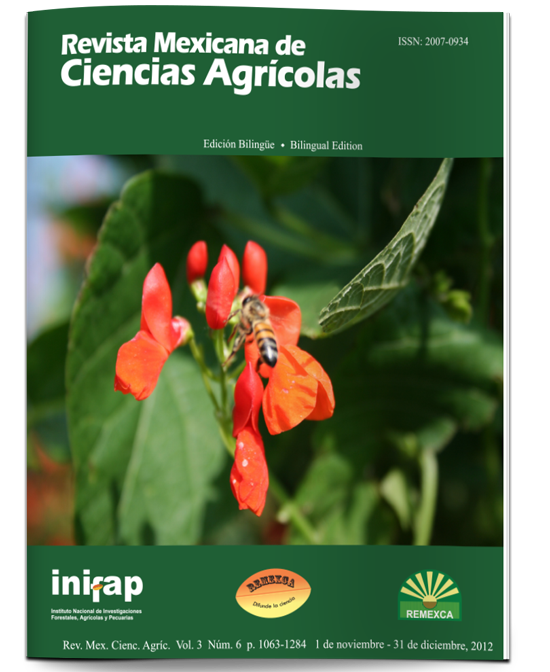Susceptibility and resistance mechanisms to insecticides in Bactericera cockerelli (Sulc.) in Coahuila, Mexico
DOI:
https://doi.org/10.29312/remexca.v3i6.1365Keywords:
co toxicity coefficient, enzymatic resistanc, psyllidAbstract
Bactericera cockerelli (Sulc.) causes significant losses in potato (Solanum tuberosum L.) in northeastern Mexico. Its control is based on the application of insecticides, but producers perceive that its control is unsatisfactory and an increased number of applications. Therefore, the objective of this research was to determine the level of susceptibility and resistance metabolic mechanisms involved, by evaluating the following insecticides Cyalotrina, deltamethrin, imidacloprid, Omethoate, Dimethoate, Malathion, Endosulfan, Carbofuran, Methomyl, Primicarb and Spinosad alone and in combination with the synergists diethyl maleate (DEM); SSS- tributylphosphorotrithoate (DEF) and piperonyl butoxide (PB). To do this, adults were collected from B. cockerelli on potato producing areas of the state of Coahuila, to conduce the bioassays, it was used the leaf immersion method proposed by the Action Committee Insecticide Resistance IRAC (for its acronym in English). It was found that the lowest LC50 for B. cockerelli presented by the products Deltamethrin, Endosulfan, Pirimicarb and Spinosad (31.2, 149.31, 155.79 and 156.64 ppm respectively). In the mixture of the insecticide synergists, the highest values of synergism were obtained with DEF, indicating the esterases enzymes are the metabolic mechanism of resistance with a greater presence for the study population.
Downloads
Downloads
Published
How to Cite
Issue
Section
License
The authors who publish in Revista Mexicana de Ciencias Agrícolas accept the following conditions:
In accordance with copyright laws, Revista Mexicana de Ciencias Agrícolas recognizes and respects the authors’ moral right and ownership of property rights which will be transferred to the journal for dissemination in open access. Invariably, all the authors have to sign a letter of transfer of property rights and of originality of the article to Instituto Nacional de Investigaciones Forestales, Agrícolas y Pecuarias (INIFAP) [National Institute of Forestry, Agricultural and Livestock Research]. The author(s) must pay a fee for the reception of articles before proceeding to editorial review.
All the texts published by Revista Mexicana de Ciencias Agrícolas —with no exception— are distributed under a Creative Commons License Attribution-NonCommercial 4.0 International (CC BY-NC 4.0), which allows third parties to use the publication as long as the work’s authorship and its first publication in this journal are mentioned.
The author(s) can enter into independent and additional contractual agreements for the nonexclusive distribution of the version of the article published in Revista Mexicana de Ciencias Agrícolas (for example include it into an institutional repository or publish it in a book) as long as it is clearly and explicitly indicated that the work was published for the first time in Revista Mexicana de Ciencias Agrícolas.
For all the above, the authors shall send the Letter-transfer of Property Rights for the first publication duly filled in and signed by the author(s). This form must be sent as a PDF file to: revista_atm@yahoo.com.mx; cienciasagricola@inifap.gob.mx; remexca2017@gmail.
This work is licensed under a Creative Commons Attribution-Noncommercial 4.0 International license.



